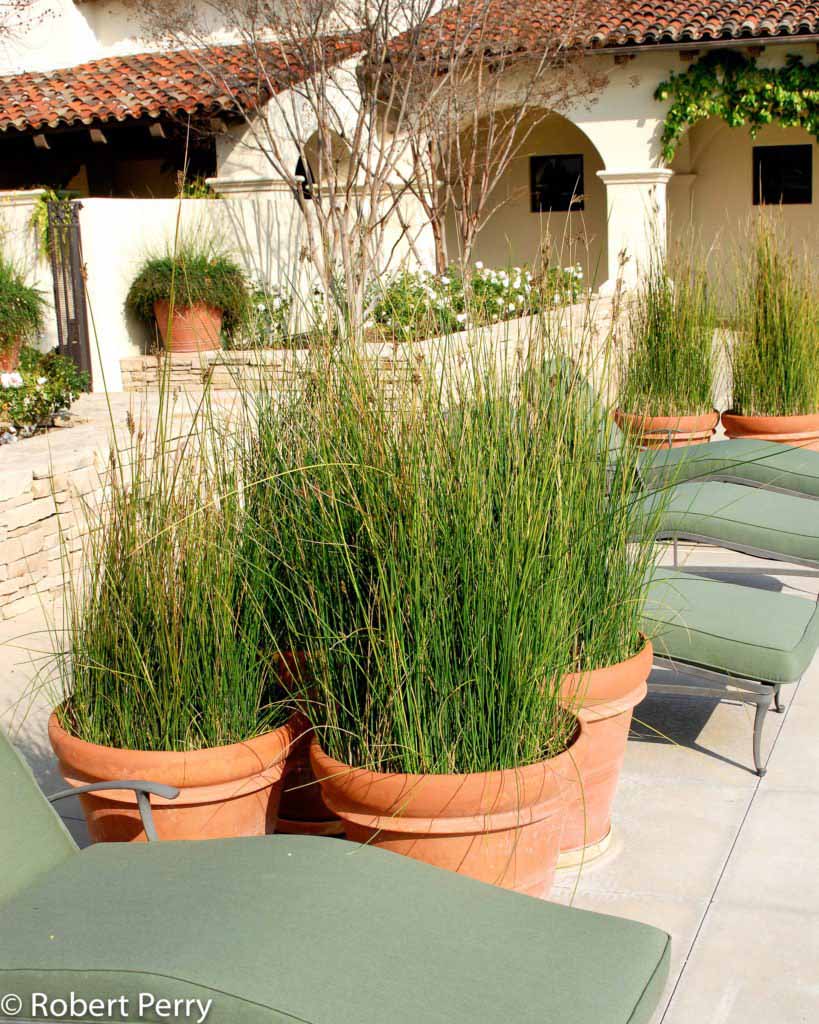The Basket rush is the tallest species of Juncus in landscape use in the Inland Empire. It develops numerous dark green stems, growing 2-3 ft. high and spreads by underground rhizomes to form dense groupings as space permits. This species is endemic to California where it grows in wetlands, and like other native rushes, this species offers value for basketry, restoration projects, bioswales and for use in ornamental landscape designs in containers.
Basket rush
Juncus textilis
Description
Plant properties
Water needs
Maintenance
Commercial sites
Plant Type: Grass, Rush, Native
Foliage Character: Evergreen
Habit: Upright, Spreading, Dense, Clumping
Growth Rate: Fast
Foliage Color: Dark green
Flower Color: Brown
Flower Season: Spring
Soil Adaptations: Moist soil
Exposure Adaptations: All day sun, Morning sun, Moderate shade, Heat, Frost
Function: Near pools and water features, Mass planting, Grouped, Foliage accent plant, Container plant, Commercial spaces, Borders, Background plant, Wildlife value, Restoration, Residential spaces, Parks and open space
Height: 2 ft. – 3 ft.
Width: 5 ft. – 6 ft.
Foliage Character: Evergreen
Habit: Upright, Spreading, Dense, Clumping
Growth Rate: Fast
Foliage Color: Dark green
Flower Color: Brown
Flower Season: Spring
Soil Adaptations: Moist soil
Exposure Adaptations: All day sun, Morning sun, Moderate shade, Heat, Frost
Function: Near pools and water features, Mass planting, Grouped, Foliage accent plant, Container plant, Commercial spaces, Borders, Background plant, Wildlife value, Restoration, Residential spaces, Parks and open space
Height: 2 ft. – 3 ft.
Width: 5 ft. – 6 ft.
Watering Schedule: Medium
For most situations, we recommend watering once per week after establishment, watering very deeply in summer, less deeply in fall and spring, and even less in winter.
See our recommendations for how much water to apply each time you water, below. Note that these recommendations are intended for inland valley areas of Southern California including the Inland Empire, San Gabriel, and San Fernando Valleys. People in cooler or warmer areas may use this as a baseline but should adjust based on local needs.
Learn how to provide 1” of water to your landscape here, and adjust to provide more or less based on the recommendations above for each time of year.
Seasonal Watering Recommendations
- June – August: once per week, water deeply, applying approximately 1.25” of irrigation.
- September – October: once per week, water deeply, applying approximately 0.75” of irrigation.
- November – February: once per week, water deeply, applying approximately 0.5” of irrigation.
- March-May: once per week, water deeply, applying approximately 0.75” of irrigation.
Learn how to provide 1” of water to your landscape here, and adjust to provide more or less based on the recommendations above for each time of year.
Adjusting to your local needs
These recommendations for Medium / Moderate water demanding plants were created for Southern California inland valley areas. Southern California areas closer to the coast and along the coast will usually be able to water significantly less during the warm months of the year. For desert areas, check with local experts to be sure plants are appropriate for the area and anticipate needing to water more.
As a very general baseline, people in Los Angeles and similar areas can try setting a schedule of 80% of the in Spring, Summer, and Fall and adjust as necessary based on observation. The difference is less pronounced in the winter months, so we recommend starting with the same recommendations as above for winter. People in cooler coastal areas such as Santa Monica can try using this same approach but adjust to use 75% of the chart recommended minutes for the Spring, Summer, and Fall months.
Important Notes
- These are general guidelines. Always observe and adjust as necessary for your landscape.
- If it rains over 1” you will likely not need to water for at least another week, possibly longer. Before watering again, check the soil. It should be significantly dry at least 4” below the soil surface before watering again.
- It is important to group plants with the same water needs together in the landscape to avoid needing to over or under water plants when running your irrigation system.
- “Smart timers” or weather sensitive irrigation controllers such as Rachio and Hunter Hydrawise are ideal for watering plants in this category because they will automatically adjust how much they water based on the weather so you do not need to reprogram the timer seasonally. Rebates for these types of irrigation controllers are available through socalwatersmart.com.
This low maintenance plant is often maintained incorrectly. Never cut back plants part way. Juncus is a form of rush that, while grass like, is not a grass. Plants cut back part way generally don’t look good. To maintain, as needed, prune out individual entire leaves to the ground if they have turned brown and look messy. If the entire plant looks like it needs refreshing, cut the entire plant all the way to the ground in the late winter to encourage vigorous new spring growth (D,S). Basket Rush spreads from its roots and naturally grows in large thickets. This is not a plant for small garden spaces. In most gardens, be prepared to dig out shoots that begin to grow “out of bounds” to control growth (S).
References
Sign Up For Free
To access all the features of this website, please create an account with us. Privileges include:
- Ability to print plant groups, lists and plant profiles
- Create your own plant groups
- Receive monthly updates by email
An online resource for you to learn about and choose the best plants for your inland Southern California landscape.
Promoting water conservation through education, stormwater capture, waterwise landscapes, and other initiatives.
We provide programs, services, and resources to serve audiences of all ages to cultivate a community-wide conservation ethic and build regional capacity for water resilience.






